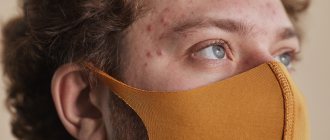What is this disease?
Herpetic stomatitis is a pathological process that develops in the mucous membrane lining the oral cavity. The causative agent of this disease is herpes simplex virus type 1. In children under the age of five, this virus is detected in 60% of all cases. By adolescence, it is detected in the vast majority of people. Herpes stomatitis in children develops during the baby’s first contact with the virus. This occurs most often before the age of three.
The high incidence is explained by:
- low level of production of own antibodies;
- immaturity of cellular immunity;
- the fact that the baby does not receive antibodies from mother's milk;
- high reactivity of the child's body.
If the baby is bottle-fed, he may get sick in the first months of life. Viral infection often goes into a latent state. It persists in the nerve ganglia.
Symptoms of streptoderma
Streptoderma in children occurs with severe symptoms:
- temperature rise to 39°C;
- intoxication;
- enlarged lymph nodes.
The condition of the skin differs depending on the form of the disease:
- Superficial. First, red spots appear on the skin. After 2-3 days they transform into blisters with a cloudy liquid inside. The blisters increase to 2 cm in diameter, then burst. In their place, yellow crusts form. Subsequently, the skin in this place heals, and the disease spreads further.
- Dry. This form is more common in boys. White and pink spots up to 5 cm in diameter form on the skin. They are located on the face, neck, ears, arms and legs, and are gradually covered with a scab. After healing, scars may remain. These areas remain lightened and do not tan under the sun.
- Streptococcal infection. The disease affects the corners of the mouth and occurs when there is a lack of vitamin B. Microcracks appear on the skin, which hurt and bleed. Then they transform into pustules that become crusty. It hurts the child to open his mouth, eating becomes difficult. Less commonly, streptococcal seizures occur in the corners of the nose or eyes.
- Felon. If streptococcus affects the periungual ridges, panaritium occurs. It is more common in children who are accustomed to biting their nails. Over time, the ulcers open up.
- Streptococcal diaper rash. This form of the disease is typical for infants. Blisters form in the folds of the skin. They gradually merge. If they are opened, pink, weeping surfaces are exposed.
Knowing how streptoderma begins in children, parents will be able to contact a dermatologist in time and begin treatment. If you delay going to the doctor, the disease becomes chronic, and achieving a complete cure becomes very difficult.
Causes
The cause of the development of the pathology is the herpes simplex virus type 1. It belongs to DNA viruses belonging to the Herpesviridae viral family. The pathogen multiplies rapidly in the epithelial cells of the oral mucosa. Then it enters nearby lymph nodes (submandibular) and continues to reproduce in them. Then it enters the blood and migrates to the parenchymal organs (spleen, liver, kidneys). There it multiplies and enters the bloodstream again. As a result, it again appears in large quantities in the epithelial cells of the skin and mucous membranes. They are massively defeated. It is localized in the oropharynx, oral cavity, nose, lips, and nearby skin. Stomatitis and herpes of the skin and mucous membranes develop when the infection generalizes simultaneously.
Children become infected with it as follows:
- through contact and everyday life (using shared utensils, toys, through kissing);
- airborne (coughing, sneezing);
- from a sick mother to the fetus through the placenta or during childbirth.
A baby can become infected from sick adults, children, and carriers.
The following factors contribute to the development of the disease:
- previously suffered inflammatory processes;
- previous antibiotic therapy;
- deficiency of microelements and vitamins in the body;
- mechanical damage to the skin and mucous membranes;
- insufficient fluid intake;
- poor oral hygiene.
In children, the virus is especially easily transmitted through contact. The infectious process quickly spreads to healthy areas.
Causes of stomatitis
In children, as in adults, stomatitis can be caused by viruses, fungi, bacteria, allergies and injuries. About six months after birth, the child loses the immunity received from the mother, the protective power of the immune system changes, and the child’s body becomes more susceptible to infections. The oral mucosa in children is more delicate and easier to injure; children also more often “bite” their cheeks after dental treatment due to a temporary loss of sensitivity after anesthesia, which causes traumatic stomatitis.
Children are not always motivated to brush their teeth, so poor hygiene can also cause stomatitis.
With the following diseases, stomatitis is observed in children much more often: chronic tonsillitis, diabetes mellitus, heart defects, chronic hepatitis.
Classification
According to the flow, acute, chronic, and wave-like variants of the pathology are distinguished. The following degrees of severity of the pathological process are distinguished:
- Mild - it is typically characterized by a slight increase in body temperature, moderate inflammation of the mucous membrane in the mouth, and enlargement of regional lymph nodes. Rashes form on the mucous membrane and skin.
- Medium – high temperature rises. Severe weakness and sudden deterioration in health. The baby begins to vomit and the pain in the mouth increases. Significant rashes appear in the mouth and the skin around it.
- Severe - a severe headache is added to the pathological process. High temperature rises, severe muscle pain. Not only regional but also distant lymph nodes enlarge. The rashes are located not only in the oral cavity, but on the skin next to it. They appear on the mucous membrane of the eye, on the eyelids, and on other parts of the face.
The severity of the pathology depends on the viral load (the amount of virus in the body) and the general reactivity of the body.
Treatment of rash on lips
Whatever the reason for the appearance of a rash on the lips, not only the help of a doctor is necessary, but also the establishment of normal skin care, the elimination of external irritants (if it is an allergy), and correction of the nutritional diet. In general, you probably can’t do without contacting a medical specialist.
It is he who must determine the current condition of the skin, choose the right method of therapy and subsequent skin care. If you follow the doctor's instructions, you will probably soon get rid of problems associated with skin diseases and rashes.
After the initial diagnosis, additional tests are prescribed to confirm the diagnosis and the immediate therapeutic course. All this must be done on time, without ignoring the occurrence of a rash on the lips ,
like most people do. In this case, you will protect yourself from possible complications and the development of dangerous diseases. Chronic diseases can be expressed by severe peeling, cracking, extreme dryness and the fact that the skin may become thicker.
Therefore, it’s time to think about how important it is to follow the correct regime, a normal diet and monitor the condition of every part of your body, including your lips.
Updated: 2019-12-20
Methods for diagnosing skin diseases:
- Diagnosis of skin diseases
- Diagnosis of skin diseases at home
- Diagnosis of allergic skin diseases
- Diagnosis of bacterial skin diseases
- Diagnosis of viral skin diseases
- Diagnosis of hair diseases
- Diagnosis of nail diseases
- Diagnosis of skin tumors
- Skin scraping
- Blisters on the skin
- Dermatoscopy
- Demodex tests
- Diagnosis of sexually transmitted infections
- Mushroom tests
- Skin scraping
Clinical manifestations
Stomatitis in children is characterized by a gradual onset of the disease. Clinical signs of the disease do not appear immediately after infection. The incubation period is typical for this pathology; it lasts from two days to three weeks.
Symptoms of herpetic stomatitis in children appear starting from the prodromal period.
Each period has its own clinic:
- Latent – lasts up to two weeks. The child's sleep is disturbed and he refuses to eat. The baby becomes restless and whiny. He has increased salivation, possible nausea and vomiting. The lymph nodes are enlarged and painful on palpation.
- The height of the disease - at this time rashes appear on the skin and mucous membranes. They are located on the soft, hard palate, gums, cheeks, lips and tongue. They are group or single, up to three millimeters in size. They are thin-walled bubbles filled with a clear liquid. Their formation lasts up to four days. The vesicles quickly open, then erosions and painful aphthae form. They are shallow ulcers covered with a white coating. The mucous membrane in the mouth is swollen and bleeding. The child develops a high temperature of up to 40 degrees. A runny nose, cough, and conjunctivitis occur.
- Fading - aphthae, erosions gradually heal and epithelialize. These formations heal without scarring. Often there is a wavy course of the disease. The periods of appearance of rashes alternate with rises in temperature.
The illness usually lasts up to two weeks. In children under one year of age, generalization of the process is possible. The development of sepsis, damage to all internal organs and meninges is likely.
Coxsackievirus in children: herpangina and hand-foot-mouth disease
Authors : Medscape Medical News
Among enteroviral diseases, the two most common forms are hand-foot-mouth disease and herpangina.
Atypical manifestations of enterovirus rashes are much less common and can imitate rubella, scarlet fever, Kawasaki disease, sudden exanthema and many other diseases, however, even with an atypical course, upon closer examination the child still has aphthae in the mouth or pharynx, and/or typical dense blisters on flexor surfaces of the palms and feet. It is these typical manifestations that allow a correct diagnosis to be made.
The subject of our consideration will be the typical forms of manifestation of these enteroviral diseases.
HAND-FOOT-MOUTH DISEASE
The name of this disease comes from the English Hand, Foot and Mouth Disease (HFMD).
Hand-foot-mouth disease (HFMD) is caused by the Coxsackievirus, a member of the enterovirus family. HFMD most often affects children under 10 years of age, but people of any age can get the infection.
Symptoms
The disease is manifested by fever (high temperature) and red spots with blisters in the center. Most often, the rash with HFMD is located in the mouth (tongue, gums), arms and legs (hence the name of the disease), but can also affect the buttocks, especially the perianal area, and appear as single elements on any part of the body. Typically, HFMD lasts about 10 days, with incidence typically peaking in late summer and fall.
Contrary to popular belief, your child cannot get HFMD from animals.
Treatment
- There are no antiviral drugs that can suppress enteroviruses.
The body copes with this disease on its own. The essence of treatment is to alleviate the child’s symptoms, prevent dehydration and identify complications.
- A child's fever can be relieved with drugs based on ibuprofen or paracetamol, and they can also be taken to relieve pain in the mouth. You just need to consult your doctor about the optimal dose and method of administering the drug.
Never give your child aspirin without a doctor's permission - aspirin provokes the development of an extremely serious disease - Reye's syndrome.
There are recommendations for the use of lidocaine gels for local anesthesia of ulcers and inflammation in the mouth.
Daily regime
If your child feels tired or sick, you should allow him to rest as much as possible. If the child is energetic and cheerful, then you should not insist on rest; let him play and spend the day as usual.
Nutrition
If a child has painful mouth sores, he or she will likely eat less or stop eating and drinking completely. It is important not only to relieve pain from the rash, but also to offer him pureed, easily digestible foods that do not irritate the oral mucosa. These include yoghurts, puddings, milkshakes, jellies, purees, etc. It's best to eat these foods cool or at room temperature, not hot.
Do not give your child spicy, salty or sour foods. There is no need to feed him citrus juices and carbonated drinks. These fluids can make your child's mouth feel worse. Offer to drink from a cup rather than a bottle—negative sucking pressure also increases pain and promotes mucosal trauma and bleeding. Drinking through a straw is safe - it can be a complete alternative to a bottle, especially for aphthae on the lips and tip of the tongue.
Children's institutions
The child can return to the children's group after normalization of body temperature and general condition, but the main indicator will be the disappearance of elements of the rash. Until this moment, going out in public is not advisable, since the child may be contagious to others.
Contact your doctor if:
- The blisters filled with pus or became sharply painful. This may be a sign of a secondary infection.
- Your child's mouth sores are so painful that he won't open his mouth and completely refuses to eat or drink.
See a doctor immediately or call an ambulance if:
- Your child is dehydrated due to complete refusal to eat or drink. We can talk about dehydration if: the child has not urinated for more than 8 hours
- the baby can feel a sharply sunken fontanel on the head
- baby crying without tears
- his lips are cracked and dry.
GERPANGINA
Herpangina is a viral disease that is caused by the same Coxsackie viruses and is manifested by the formation of painful ulcers (ulcers) in the throat and mouth, as well as severe sore throat and fever.
Herpangina is one of the common childhood infections. It most often occurs in children aged 3 to 10 years, but can affect people in any age group.
Herpangina symptoms:
- Fever
- Headache
- Loss of appetite
- Sore throat: constant or only when swallowing
- Ulcers in the mouth and throat, which may also be accompanied by isolated rashes on the legs, arms and buttocks (as in hand-foot-mouth disease).
- Aphthae usually range in size from 1 to 6 mm, are white or whitish-gray in color, with a red border around the edges. They can be very painful.
Usually no additional diagnostic methods are required - the doctor makes a diagnosis based on a physical examination and medical history.
Treatment
Treatment and care are similar to those described for hand-foot-mouth disease. Herpangina usually goes away within a week.
As with hand-foot-mouth disease, and with herpangina, the main complications are considered to be dehydration and aseptic meningitis. Therefore, you should closely monitor your child for signs of dehydration and headache levels, and consult a doctor immediately if you suspect complications.
Fortunately, complications are quite rare and most children recover within 10 days.
During a child’s illness, all family members must maintain careful hygiene: wet cleaning more often than usual, using dishes separately, frequently washing their hands and treating them with antiseptics.
published 08/08/2017 07:00 updated 10/08/2017 — Infectious diseases
Diagnostics
A patient suspected of having this disease is examined by a dentist. He asks the child’s parents about how the disease progressed. The diagnosis is established on the basis of the characteristic clinical picture of stomatitis, revealed during examination, anamnesis and characteristic complaints. Upon examination, typical mucosal lesions are revealed.
To confirm the diagnosis, laboratory testing of scrapings of the oral mucosa, the contents of ulcers, the patient’s saliva and blood is used.
The following are used for research:
- cytopolymerase chain reaction;
- immunofluorescence method;
- serological blood tests (RSC, ELISA, immunoglobulin M test);
- HSV test for the detection of immunodot G-specific glycoprotein.
These methods are used only for severe infections, as they are quite expensive.
Treatment
Treatment of herpetic stomatitis in children with mild and moderate forms is carried out on an outpatient basis. In severe cases and the development of complications, the baby is hospitalized. Treatment is carried out under the supervision of a pediatric dentist or periodontist.
Children are prescribed bed rest and a diet with pureed, non-irritating food. He is given separate hygiene items and dishes. Plenty of warm fluids are recommended.
The following drugs are prescribed:
- Non-steroidal anti-inflammatory drugs (Nise, Paracetamol, Nurofen) are used to relieve temperature and inflammatory reactions.
- Antihistamines (Clemastine, Loratadine) are used to relieve swelling of the mucous membranes.
- Antiviral drugs (Famciclovir, Acyclovir, Zovirax) are used at the beginning of treatment or in severe cases.
- Immunomodulators (Lysozyme, Gamma globulin, Thymogen) are used to enhance immunity.
During treatment, vitamin-mineral complexes and fish oil are used in monthly courses.
Local drugs that act directly on the mucous membrane are widely used.
For local treatment of herpetic stomatitis the following are used:
- antiseptics (Hexoral, Miramistin) - they are used to rinse the mouth every four hours for two weeks;
- ointments and gels with anesthetics (Kamistad, Lidochlor gel) are used for pain relief, they are lubricated with mucous membranes three times a day for up to two weeks;
- antiviral agents (Ganciclovir, Acicovir) - destroy the viral cell, gums are treated with these ointments five times a day, two weeks;
- proteolytic enzymes (Trepsin, Chymotrypsin) are used to cleanse the necrotic surfaces of ulcers; they are washed with these solutions twice a day.
- rinsing with decoctions of medicinal herbs (calendula, chamomile, sage) is carried out after each meal for up to two weeks;
- epithelializing ointments (Solcoseryl, Methyluracil) are used to enhance the healing of erosions and ulcers, used in the recovery stage, used up to four times a day for ten days.
Physiotherapy is applied locally. Irradiation of affected mucous membranes with ultraviolet and infrared rays is used.
Prevention of streptoderma
To reduce the likelihood of developing streptoderma in a child, follow the rules of prevention:
- observe the rules of hygiene;
- treat skin lesions with antiseptics;
- strengthen your immune system with vitamin complexes and good nutrition;
- do not wash your child with soap too often;
- At the first symptoms of any disease, consult your doctor.
Streptoderma is a curable disease, but you need to see a doctor in time. The sooner treatment is started, the easier it is to avoid complications and transition to a chronic form. You can undergo a qualitative examination of your skin condition at the SM-Doctor clinic. Qualified pediatric dermatologists will make the correct diagnosis and prescribe the correct treatment.
Prevention
Preventive measures are aimed at preventing infection. This presents certain difficulties, since the vast majority of the population is infected with it. It is better if the child gets sick from it at an older age.
For this it is recommended:
- avoid contact with infected people;
- will provide personal utensils and personal hygiene products for the child;
- Kissing people with herpetic rashes is prohibited;
- strengthening the baby's immune system.
It is recommended that the child be provided with adequate nutrition and regularly given vitamin and mineral complexes.
Prevention of stomatitis in children
In children's groups, infections spread especially quickly. Therefore, if a child is infected with the herpes virus, he needs to stay at home until he recovers. Children who have been in contact with sick people should use antiviral ointments for 5 days.
If a pregnant woman has herpes or candidiasis, she should treat it before giving birth. If you have the herpes virus during the period of illness, you should use separate utensils, do not kiss children, and wear a mask.
Kindergartens and other preschool institutions must be cleaned and objects, including toys, must be treated with disinfectants.
To avoid allergic reactions, you should seek help from an allergist to identify existing allergies.
It is worth preventing a decrease in immunity; hardening works especially well in childhood. It is worth limiting your intake of fast carbohydrates, because... they create a favorable environment for the development of candidiasis. An important point is the proper nutrition of the child; regular intake of vitamins, especially vitamin C, is essential.
Tantum® Propolis
For children over 14 years of age , you can use Tantum® Propolis lozenges; they contain a lot of vitamin C, which will strengthen the immune system, and propolis has an anti-inflammatory effect, preventing the occurrence of infections.7
Find out more
Prevention of Bednar's aft is preparing the breasts for feeding, using special creams to soften the skin, prevent cracks, and it is also worth choosing the right bottle. In case of injury due to braces, you need to use orthodontic wax; here it is important to prevent the wounds from becoming infected, so it is better to treat them with antiseptic solutions and sprays.
Tantum® Verde spray will relieve pain at the site of injury and its antiseptic effect will prevent infection.8,9









